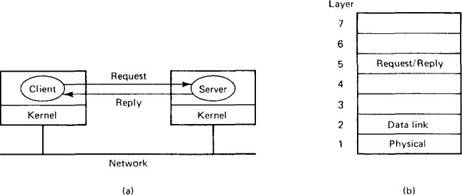Книга: Distributed operating systems
2.3.1. Clients and Servers
2.3.1. Clients and Servers
This something is often the client-server model that we introduced in the preceding chapter. The idea behind this model is to structure the operating system as a group of cooperating processes, called servers, that offer services to the users, called clients. The client and server machines normally all run the same microkernel, with both the clients and servers running as user processes, as we saw earlier. A machine may run a single process, or it may run multiple clients, multiple servers, or a mixture of the two.

Fig. 2-7. The client-server model. Although all message passing is actually done by the kernels, this simplified form of drawing will be used when there is no ambiguity.
To avoid the considerable overhead of the connection-oriented protocols such as OSI or TCP/IP, the client server model is usually based on a simple, connectionless request/reply protocol. The client sends a request message to the server asking for some service (e.g., read a block of a file). The server does the work and returns the data requested or an error code indicating why the work could not be performed, as depicted in Fig. 2-7(a).
The primary advantage of Fig. 2-7(a) is the simplicity. The client sends a request and gets an answer. No connection has to be established before use or torn down afterward. The reply message serves as the acknowledgement to the request.
From the simplicity comes another advantage: efficiency. The protocol stack is shorter and thus more efficient. Assuming that all the machines are identical, only three levels of protocol are needed, as shown in Fig. 2-7(b). The physical and data link protocols take care of getting the packets from client to server and back. These are always handled by the hardware, for example, an Ethernet or token ring chip. No routing is needed and no connections are established, so layers 3 and 4 are not needed. Layer 5 is the request/reply protocol. It defines the set of legal requests and the set of legal replies to these requests. There is no session management because there are no sessions. The upper layers are not needed either.
Due to this simple structure, the communication services provided by the (micro)kernel can, for example, be reduced to two system calls, one for sending messages and one for receiving them. These system calls can be invoked through library procedures, say, send(dest, &mptr) and receive(addr, &mptr). The former sends the message pointed to by mptr to a process identified by dest and causes the caller to be blocked until the message has been sent. The latter causes the caller to be blocked until a message arrives. When one does, the message is copied to the buffer pointed to by mptr and the caller is unblocked. The addr parameter specifies the address to which the receiver is listening. Many variants of these two procedures and their parameters are possible. We will discuss some of these later in this chapter.
- Database Clients
- Graphical Clients
- 7.1.5. The Amoeba Servers
- 7.2. OBJECTS AND CAPABILITIES IN AMOEBA
- 7.6. THE AMOEBA SERVERS
- 9.7.6. Servers
- CHAPTER 8: Running DHCP clients and servers
- Creating and managing failover scopes
- Разработка приложений баз данных InterBase на Borland Delphi
- Open Source Insight and Discussion
- Introduction to Microprocessors and Microcontrollers
- Chapter 6. Traversing of tables and chains




